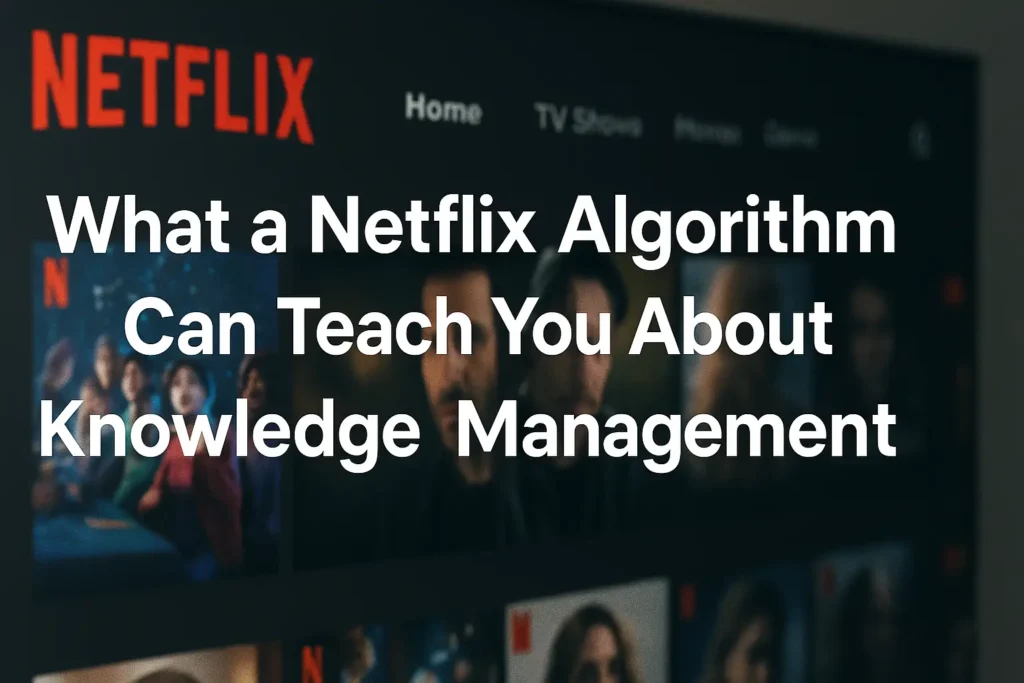Most people don’t associate Netflix’s recommendation engine with enterprise knowledge management. But the truth is, the way Netflix serves content to its users reveals a powerful lesson about how organizations can manage, surface, and deliver knowledge more effectively.
In fact, when you strip away the entertainment layer, what Netflix does is exactly what most companies struggle with: making the right content find the right person at the right time.
Let’s break it down.

1. Relevance Over Quantity
Netflix doesn’t overwhelm you with everything in its library. Instead, it curates what it thinks you’ll find useful based on your behavior. Most knowledge repositories in organizations do the opposite. They stockpile information without curating for the user.
In a typical enterprise, a document created three years ago might still be relevant, but it gets buried under outdated files or lost in poorly structured folders. The result? Employees spend more time searching than applying knowledge. According to IDC, knowledge workers spend up to 30% of their workday looking for information. That’s where a Netflix-style approach could transform KM.
Lesson: Surface what matters, not everything that exists.
2. Personalization Is Key
Netflix algorithms consider what you’ve watched, skipped, rewatched, and rated to tailor recommendations. In knowledge management, this could mean understanding what kind of content different teams access regularly, what formats work best (videos, decks, checklists), and what topics are trending across the org.
Imagine a KM system that learns from how a product manager interacts with knowledge differently than someone in HR. Over time, it surfaces the most relevant knowledge assets for each persona automatically.
Lesson: One-size-fits-all knowledge delivery is broken. Personalization creates engagement.
3. Metadata Matters
The Netflix engine doesn’t just rely on the movie title. It tags content with genres, actors, languages, runtime, mood, and dozens of other data points. This deep metadata makes filtering and discovery seamless.
In KM, metadata is often an afterthought. Documents get uploaded without tags, or with inconsistent categorization. That makes it difficult for users to retrieve them later.
Lesson: Rich metadata isn’t optional. It’s foundational.
4. Feedback Loops Drive Continuous Improvement
When you give a thumbs up or down on Netflix, you’re not just affecting your own recommendations. You’re training the system. The more data it has, the better it gets at predicting what you’ll want next.
KM systems need this too. If employees can upvote, comment, or suggest improvements on content, then the knowledge base evolves with real use cases. Without feedback, KM turns static—and static knowledge quickly becomes obsolete.
Lesson: Let your users shape the knowledge experience.
5. Search Is Not the Primary Interface
On Netflix, you don’t have to search unless you want to. Content is served to you before you even know what you’re looking for. KM platforms can learn from this proactive discovery.
Using AI, machine learning, and user data, modern KM systems can anticipate needs. For instance, when onboarding a new employee, the system could recommend critical policies, past project learnings, or expert contacts without a manual search.
Lesson: Push knowledge proactively, not just on demand.
6. Context Is Everything
Netflix recommendations shift depending on time of day, location, and device. It knows that what you want to watch on a Monday morning on your phone might differ from a Friday night on your TV.
In KM, the context in which knowledge is accessed should also shape how it’s delivered. If someone is in a meeting, short summaries or checklists might be more useful than long-form reports. If they’re offline, mobile-friendly knowledge becomes critical.
Lesson: Deliver knowledge in the right format, at the right moment.
Closing Thoughts
Netflix has mastered the art of content discoverability, personalization, and delivery. KM systems that want to stay relevant in a digital-first world must adopt similar principles.
This doesn’t mean building an entertainment platform for your company’s documents. But it does mean recognizing that the way we consume information has changed—and your KM strategy must evolve too.
When knowledge finds the user, not the other way around, that’s when true knowledge management begins.
Read: Making the Business Case for Knowledge Management Investment
Subscribe to receive notifications for free webinars on Knowledge Management.
